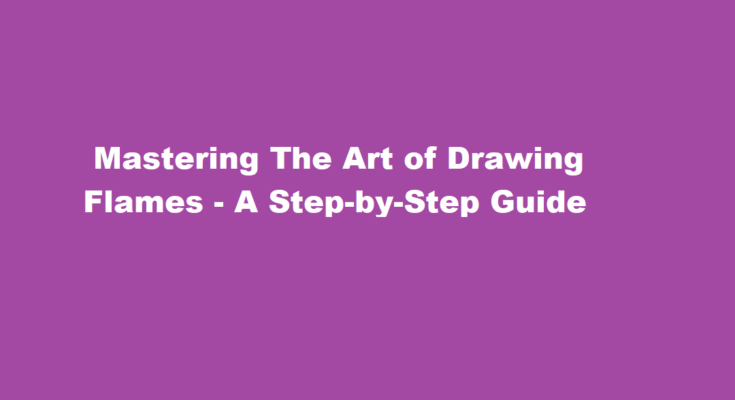Introduction
Flames are a captivating and dynamic element that can add drama, energy, and intensity to your artwork. Whether you’re an aspiring artist or a seasoned pro, mastering the art of drawing flames can be a valuable skill in your creative arsenal. In this step-by-step guide, we will explore the techniques and tips to help you draw flames convincingly and with a sense of realism.
Materials You’ll Need
Before we dive into the process, it’s important to gather the right materials. You’ll need
1. Paper: Select a high-quality paper that can handle various drawing techniques. Heavyweight or bristol paper is an excellent choice.
2. Pencils: A set of graphite pencils ranging from H (hard) to 8B (soft) for shading and outlining.
3. Erasers: Both a kneaded eraser and a precision eraser for removing and highlighting specific areas.
4. Blending tools: Tortillons or blending stumps to smoothen gradients and transitions.
5. Reference images: Gather images of real flames to use as references for your drawing.
Study Flame Anatomy
Understanding the anatomy of flames is essential before you start drawing. Flames consist of several distinct parts, including the base, core, and outer edges. The base is where the flame meets the source of combustion, while the core is the hottest and brightest part. The outer edges are cooler and often have a more transparent appearance. This knowledge will help you capture the essence of a real flame in your drawing.
Sketch the Basic Shape
Begin your flame drawing with a light pencil sketch of the basic shape. Flames come in various forms, such as teardrop, candle-like, or irregular shapes. Decide on the style you want to draw and lightly sketch the outline of the flame’s base.
Define the Core
The core of the flame is where the intense heat and brightness reside. Use a softer pencil, like 6B or 8B, to darken this area. Gradually build up the shading and pay attention to the contours of the core. It’s important to maintain a sense of flow and movement in this region.
Add Detail and Texture
To give your flames a realistic look, add texture and detail. Observe the intricate patterns within a real flame and replicate them in your drawing. Use a combination of short, flickering lines and circular motions with your pencil. This will create the sense of turbulence and heat within the flame.
Shade the Base
The base of the flame is often less intense and cooler in color. Use a lighter pencil (e.g., 2B or 4B) to shade the base, leaving it slightly translucent. Pay attention to the transitions between the core and the base, ensuring a smooth gradient.
Work on the Edges
The outer edges of the flame have a more delicate and wispy appearance. Use a light touch with your pencil to sketch these edges, keeping them irregular and uneven. The edges should look as if they’re dancing and flickering.
Smudge and Blend
To create a seamless transition between different parts of the flame, use blending tools like tortillons or blending stumps. Gently smudge and blend the pencil strokes to soften the edges and create a realistic gradient of heat and light.
Highlights and Reflections
Pay close attention to where the light source interacts with the flame. Add highlights and reflections to make your flame appear more three-dimensional. Use a kneaded eraser to lift small areas of graphite and create these highlights. The reflection of the flame on nearby surfaces can also be a compelling addition.
Refine and Define
Take a step back and evaluate your drawing. Refine any areas that need improvement and add additional layers of shading or detail as necessary. Ensure that your flame maintains a sense of movement and energy.
Background and Composition
Consider the context in which your flame exists. Decide on the background and composition of your artwork. The interplay between the flame and its surroundings can enhance the overall impact of your drawing.
FREQUENTLY ASKED QUESTIONS
What is flame art?
Fire art is a piece of art that uses active flames as an essential part of the piece. The piece may either use flame effects as part of a sculpture, or be a choreographed performance of fire effects as the piece burns; the latter being almost a type of performance art.
What is candle flame?
Candles produce light by releasing heat and all the turn on the candle, produces come from a chemical reaction known as combustion in which wax reacts with oxygen in the air to produce carbon dioxide. The substances that evaporate while burning produces the flame.
Conclusion
Drawing flames requires careful observation, attention to detail, and the use of various shading and blending techniques. With practice, you can capture the essence of this dynamic and mesmerizing element in your artwork. Remember that flames are not only about heat and light but also about movement and emotion. Use this step-by-step guide as a foundation, and let your creativity ignite as you master the art of drawing flames.
Read Also : A Step-by-Step Guide to Turning Off Restricted Mode



